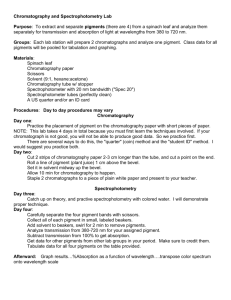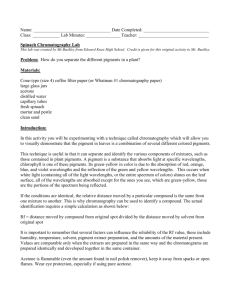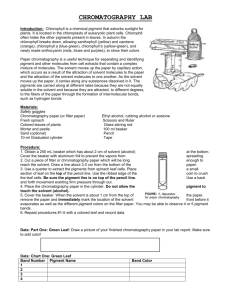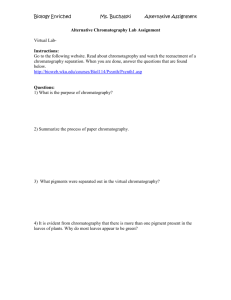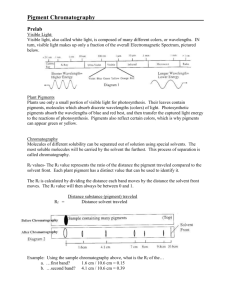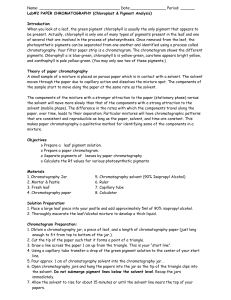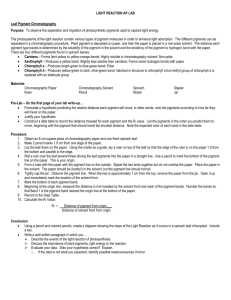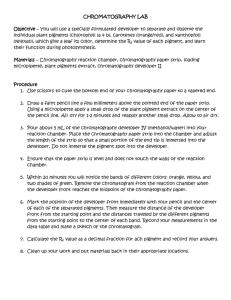Leaf Chromatography
advertisement
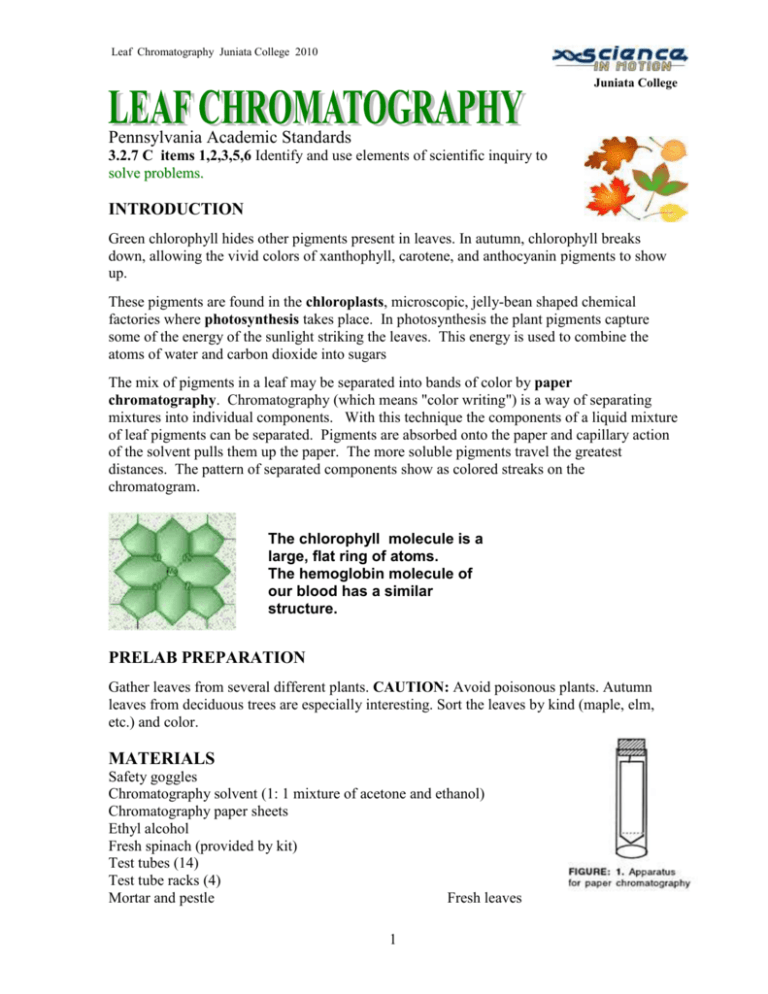
Leaf Chromatography Juniata College 2010 Juniata College Pennsylvania Academic Standards 3.2.7 C items 1,2,3,5,6 Identify and use elements of scientific inquiry to solve problems. INTRODUCTION Green chlorophyll hides other pigments present in leaves. In autumn, chlorophyll breaks down, allowing the vivid colors of xanthophyll, carotene, and anthocyanin pigments to show up. These pigments are found in the chloroplasts, microscopic, jelly-bean shaped chemical factories where photosynthesis takes place. In photosynthesis the plant pigments capture some of the energy of the sunlight striking the leaves. This energy is used to combine the atoms of water and carbon dioxide into sugars The mix of pigments in a leaf may be separated into bands of color by paper chromatography. Chromatography (which means "color writing") is a way of separating mixtures into individual components. With this technique the components of a liquid mixture of leaf pigments can be separated. Pigments are absorbed onto the paper and capillary action of the solvent pulls them up the paper. The more soluble pigments travel the greatest distances. The pattern of separated components show as colored streaks on the chromatogram. The chlorophyll molecule is a large, flat ring of atoms. The hemoglobin molecule of our blood has a similar structure. PRELAB PREPARATION Gather leaves from several different plants. CAUTION: Avoid poisonous plants. Autumn leaves from deciduous trees are especially interesting. Sort the leaves by kind (maple, elm, etc.) and color. MATERIALS Safety goggles Chromatography solvent (1: 1 mixture of acetone and ethanol) Chromatography paper sheets Ethyl alcohol Fresh spinach (provided by kit) Test tubes (14) Test tube racks (4) Mortar and pestle Fresh leaves 1 Leaf Chromatography Juniata College 2010 (provided by teacher} Sand in container 10 ml graduated cylinders (7) Scissors and rulers (2, 7) Glass stirring rod (7) Corks with paper clips (14) Extra corks PROCEDURE Leaves should be grouped by species (maple, etc.) and color. Each team (or individual) works with a spinach leaf and, if possible, one other species. CAUTION: Chromatography solvents are flammable and toxic. Have no open flames; maintain good ventilation; and avoid inhaling fumes. 1. Cut a strip of filter paper paper 1 X 9.5 cm. so that it fits inside the test tube. Cut a point in the bottom 0.5 cm of the strip, as in Figure 1. . Draw a faint pencil line across the top of the point as shown in figure 1. Attach the paper strip to the paper clip so that it hangs inside the tube, as shown. The strip should not touch the sides of the test tube. 2. Tear a spinach leaf into very small pieces. Place them into a mortar along with a pinch or two of sand to help with grinding. Add about 5 ml ethyl alcohol to the leaf pieces. Crush leaves with the pestle, using a circular motion, until the mixture is finely ground. The pigment extract is now ready for paper chromatography. To save time, the teacher can grind spinach and other leaves for the whole class. 3. Use a glass rod to touch a small drop of the pigment extract to the center of the pencil line on the paper strip. Let dry. Repeat as many as 10 times, to build up the pigment dot. NOTE: It is important that the dot is dry before another drop is added. This keeps the pigment dot from spreading out. 4. Pour 1.5 ml chromatography solvent (1:1 mixture of ethanol and acetone) into the test tube. Fit the paper and cork assembly inside. Adjust it so that the paper point is only about one mm into the solvent. Do not let the paper touch the sides of the tube. The pigment dot must be above the level of the solvent. Watch the solvent rise up the paper, separating the pigments as it goes. At the instant the solvent reaches the top, remove the paper and let it dry. Observe the bands of pigment. The order, from the top, should be carotenes (orange), xanthophylls (yellow), chlorophyll a (green), chlorophyll b (gray-green or blue-green), and anthocyanin (red). Identify and label all the pigment bands you see on the dry strip. Write the species of leaf on the strip as well. Record the species, external color, and chromatogram pigments in the DATA TABLE of your report sheet. 5. Each pigment has an rf value, the distance it moves up the paper compared with the distance traveled by the solvent. 2 Leaf Chromatography Juniata College 2010 Measure the distance in cm from the starting point (pencil line) to the center of each pigment band. Then measure the entire distance traveled by the solvent. Remember, the starting point for the solvent is also the pencil line and the ending point for the solvent is the top edge of the paper. Do the required divisions and record your Rf values in the DATA TABLE of your report sheet. 6. Wash the mortar and pestle thoroughly, using a little alcohol to remove any remaining pigment. 7. Repeat steps 1 through 6 for each species. CHROMATOGRAM DATA: SPINACH LEAF COLOR, FROM TOP NAME OF PIGMENT Rf OF PIGMENT CHROMATOGRAM DATA: SPECIES NAME_______________ COLOR, FROM TOP NAME OF PIGMENT 3 Rf OF PIGMENT Leaf Chromatography Juniata College 2010 Chlorophyll A and B in leaves are the main pigments that absorb the energy of sunlight. Carotenes and xanthophylls are pigments that absorb the energy of sunlight and transfer it to chlorophyll. The red, orange, and yellow colors of tomatoes and peppers are due to these pigments. Anthocyanins are the pigments in pink, red, and purple flowers. Anthocyanins attract pollinating insects and may also act as a sunscreen to leaves and flowers. NAME________________ WORKSHEET QUESTIONS SECTION_____________ DATE________________ 1. Which have stronger pigment spots on the chromatogram, fresh spinach leaves or species of autumn leaves? Suggest a reason for this. 2. Since autumn leaves have bright colors, does the chromatogram of autumn leaves have pigments that are not found in spinach leaves? Explain your finding. 3. The leaves of some maple trees turn yellow in autumn and others turn orange-red. What pigments do you think are present that cause these differences? 4. If a plant other than spinach was run, describe the pigment differences between spinach and the other plant. Modified from Lab Dad's Laboratory http://www.geocities.com/CapeCanaveral/Hall/1410/index.html 4
